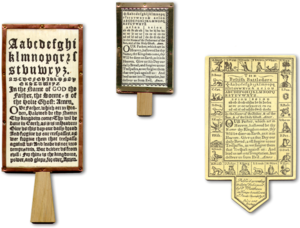Portal:Children's literature - Wikipedia
The Children's Literature Portal
Children's literature or juvenile literature includes stories, books, magazines, and poems that are created for children. Modern children's literature is classified in two different ways: genre or the intended age of the reader, from picture books for the very young to young adult fiction.
Children's literature can be traced to traditional stories like fairy tales, that have only been identified as children's literature in the eighteenth century, and songs, part of a wider oral tradition, that adults shared with children before publishing existed. The development of early children's literature, before printing was invented, is difficult to trace. Even after printing became widespread, many classic "children's" tales were originally created for adults and later adapted for a younger audience. Since the fifteenth century much literature has been aimed specifically at children, often with a moral or religious message. Children's literature has been shaped by religious sources, like Puritan traditions, or by more philosophical and scientific standpoints with the influences of Charles Darwin and John Locke. The late nineteenth and early twentieth centuries are known as the "Golden Age of Children's Literature" because many classic children's books were published then. (Full article...)
Selected article
Hymns for the Amusement of Children (1771) was the final work completed by Christopher Smart. It was completed while Smart was imprisoned for outstanding debt at the King's Bench Prison, and the work is his final exploration of religion. Smart's Hymns are one of the first works of hymns dedicated to children, and they are intended to teach Christian virtues. Unlike some of the other works produced by Smart after his release from a mental asylum, such as A Song to David or Hymns and Spiritual Songs, this work was a success and went into many immediate editions. Part of the success of this work lies in the simplicity and accessibility of the text. However, Smart died before he ever saw the proceeds of the work and never learned of the book's success.
Selected picture

Credit: History of the Horn-Book (1896)
Hornbooks were used to teach literacy in the 15th – 19th centuries.
In this month
- October 1924 – First issue of The Horn Book Magazine published in Boston, a periodical about children's literature
- 1 October 1942 – First twelve Little Golden Books are published
- 3 October 1955 – Debut of Captain Kangaroo, one of the longest-running children's television programs
- 14 October 1926 – First publication of A. A. Milne's Winnie-the-Pooh (pictured), a later Latin translation of which became the only Latin book ever to appear on The New York Times bestseller list
- 30 October 1887 – Birth of Sukumar Ray, one of the most famous Indian literary nonsense writers
Selected quote
Tyger Tyger, burning bright,
In the forests of the night :
What immortal hand or eye,
Could frame thy fearful symmetry?

